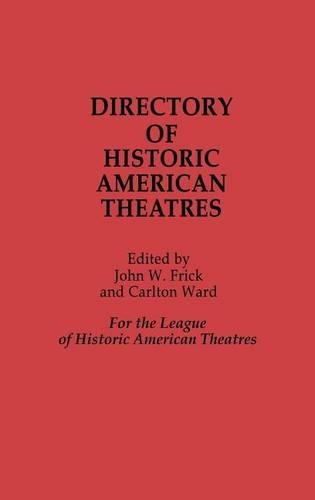
Directory of Historic American Theatres
(Hardback)
Publishing Details
Directory of Historic American Theatres
Bloomsbury Publishing PLC
Greenwood Press
20th October 1987
United States
Classifications
Tertiary Education
Non Fiction
792.02573
Physical Properties
Hardback
367
Description
A major contribution to the history of American theatre, this book records in one volume all available data about theatres built in this country before 1915. The first comprehensive reference work of its kind, the Directory of Historic American Theatres identifies 886 theatres ranging from forgotten second-floor opera houses to elaborate performance centers still in use today. The data collected here is based on exhaustive questionnaire and follow-up mailings to historical societies, libraries, theatres, and individuals involved in historic preservation.
Reviews
. . . the Directory of Historic American Theatres provides a valuable service to those interested in the discovery and restoration of historic theatres. . . .-Theatre Insight
It's heartening to learn how many of these structures still fulfill respectable dramatic and communal functions, but the book's chief value may be to help local people learn a bit of the heritage of these places to better the chances for preservation of the many buildings now vacant or used as warehouses. Both text and the eighty pictures testify to a love of theater in surprising places. . . .-American Studies
There are two indexes: the first lists names, including any variations, of the theatres; the second index lists performers, architects, theatre owners, and titles of any plays, operas, and films mentioned in the entries. . .-The Indexer
." . . the Directory of Historic American Theatres provides a valuable service to those interested in the discovery and restoration of historic theatres. . . ."-Theatre Insight
"There are two indexes: the first lists names, including any variations, of the theatres; the second index lists performers, architects, theatre owners, and titles of any plays, operas, and films mentioned in the entries. . ."-The Indexer
"It's heartening to learn how many of these structures still fulfill respectable dramatic and communal functions, but the book's chief value may be to help local people learn a bit of the heritage of these places to better the chances for preservation of the many buildings now vacant or used as warehouses. Both text and the eighty pictures testify to a love of theater in surprising places. . . ."-American Studies
Author Bio
JOHN W. FRICK teaches in the Department of Drama at the University of Virginia. CARLTON WARD is affiliated with Jacksonville State University.
